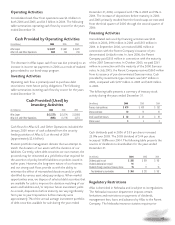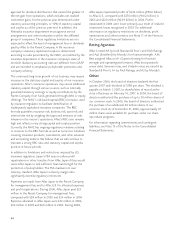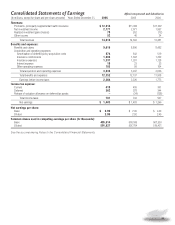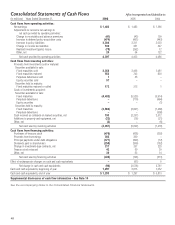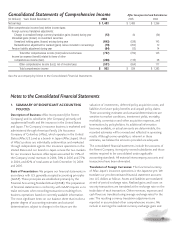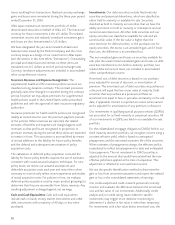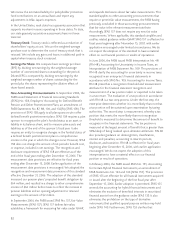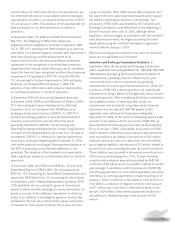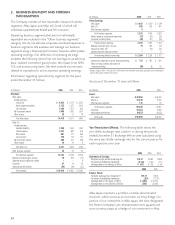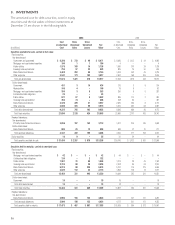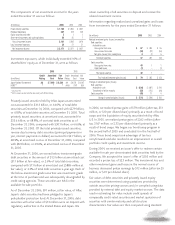Aflac 2006 Annual Report Download - page 56
Download and view the complete annual report
Please find page 56 of the 2006 Aflac annual report below. You can navigate through the pages in the report by either clicking on the pages listed below, or by using the keyword search tool below to find specific information within the annual report.
52
We review the estimated liability for policyholder protection
fund contributions on an annual basis and report any
adjustments in Aflac Japan’s expenses.
In the United States, each state has a guaranty association that
supports insolvent insurers operating in those states. To date,
our state guaranty association assessments have not been
material.
Treasury Stock: Treasury stock is reflected as a reduction of
shareholders’ equity at cost. We use the weighted-average
purchase cost to determine the cost of treasury stock that is
reissued. We include any gains and losses in additional paid-in
capital when treasury stock is reissued.
Earnings Per Share: We compute basic earnings per share
(EPS) by dividing net earnings by the weighted-average
number of unrestricted shares outstanding for the period.
Diluted EPS is computed by dividing net earnings by the
weighted-average number of shares outstanding for the
period plus the shares representing the dilutive effect of
share-based awards.
New Accounting Pronouncements: In September 2006, the
FASB issued Statement of Financial Accounting Standards
(SFAS) No. 158, Employers’ Accounting for Defined Benefit
Pension and Other Postretirement Plans, an amendment of
FASB Statements No. 87, 88, 106, and 132(R) (SFAS 158). The
provisions of SFAS 158 apply to all plan sponsors who offer
defined benefit postretirement plans. SFAS 158 requires a plan
sponsor to recognize the plan’s funded status as an asset or
liability in its balance sheet, and to measure plan assets and
liabilities as of the end of the sponsor’s fiscal year. It also
requires an entity to recognize changes in the funded status of
a defined benefit postretirement plan in comprehensive
income in the year in which the changes occur. However, SFAS
158 does not change the amount of net periodic benefit cost,
or expense, included in net earnings. The recognition and
disclosure requirements of SFAS 158 are effective as of the
end of the fiscal year ending after December 15, 2006. The
measurement date provisions are effective for fiscal years
ending after December 15, 2008. Earlier application of the
measurement date provisions is encouraged. We adopted the
recognition and measurement date provisions of this standard
effective December 31, 2006. The adoption of this standard
increased our pension plans’ projected benefit obligation by
$64 million; and resulted in a charge to other comprehensive
income of $64 million before taxes to reflect the increase in
pension liabilities and an opening adjustment to retained
earnings in the amount of $2 million.
In September 2006, the FASB issued SFAS No. 157, Fair Value
Measurements (SFAS 157). SFAS 157 defines fair value,
establishes a framework for measuring fair value under GAAP,
and expands disclosures about fair value measurements. This
standard applies to other accounting pronouncements that
require or permit fair value measurements, the FASB having
previously concluded in those accounting pronouncements
that fair value is the relevant measurement attribute.
Accordingly, SFAS 157 does not require any new fair value
measurements. Where applicable, this standard simplifies and
codifies related guidance within GAAP. SFAS 157 is effective for
fiscal years beginning after November 15, 2007, with earlier
application encouraged under limited circumstances. We do
not expect the adoption of this standard to have a material
effect on our financial position or results of operations.
In June 2006, the FASB issued FASB Interpretation No. 48
(FIN 48), Accounting for Uncertainty in Income Taxes, an
Interpretation of FASB Statement No. 109. The provisions of
FIN 48 clarify the accounting for uncertainty in income taxes
recognized in an enterprise’s financial statements in
accordance with SFAS No. 109, Accounting for Income Taxes.
FIN 48 prescribes a recognition threshold and measurement
attribute for the financial statement recognition and
measurement of a tax position taken or expected to be taken
in a tax return. The evaluation of a tax position in accordance
with FIN 48 is a two-step process. Under the first step, the
enterprise determines whether it is more-likely-than-not that
a tax position will be sustained upon examination by taxing
authorities. The second step is measurement, whereby a tax
position that meets the more-likely-than-not recognition
threshold is measured to determine the amount of benefit to
recognize in the financial statements. The tax position is
measured at the largest amount of benefit that is greater than
50% likely of being realized upon ultimate settlement. FIN 48
also provides guidance on derecognition, classification,
interest and penalties, accounting in interim periods,
disclosure, and transition. FIN 48 is effective for fiscal years
beginning after December 15, 2006, with earlier application
encouraged. We do not expect the adoption of this
interpretation to have a material effect on our financial
position or results of operations.
In February 2006, the FASB issued SFAS No. 155, Accounting
for Certain Hybrid Financial Instruments, an amendment of
FASB Statements No. 133 and 140 (SFAS 155). The provisions
of SFAS 155 are effective for all financial instruments acquired
or issued after the beginning of the first fiscal year after
September 15, 2006. Earlier adoption is permitted. SFAS 155
amends the accounting for hybrid financial instruments and
eliminates the exclusion of beneficial interests in securitized
financial assets from the guidance under SFAS 133. It also
eliminates the prohibition on the type of derivative
instruments that qualified special purpose entities may hold
under SFAS 140. Furthermore, SFAS 155 clarifies that



